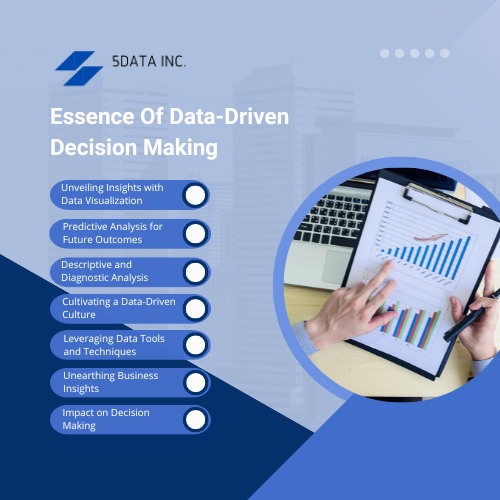Data Analysis
Data analysis encompasses the examination, purification, conversion, and modeling of data to unveil valuable insights, derive conclusions, and facilitate informed decision-making. Here’s a general overview of the steps involved in data analysis:- Define the Problem and Goals: Clearly outline the problem you’re trying to solve or the questions you want to answer through your data analysis. Understand the goals of your analysis, as this will guide your approach.
- Data Collection: Gather relevant data from various sources. It could be structured data from databases, spreadsheets, APIs, or unstructured data from text documents, images, or audio files.
- Data Cleaning and Preprocessing: Raw data frequently includes mistakes, absent values, and irregularities. Clean and preprocess the data by handling missing values, correcting errors, and transforming the data into a suitable format for analysis.
- Exploratory Data Analysis (EDA): Explore the data to understand its characteristics, patterns, and relationships. It involves generating summary statistics, visualizations, and other techniques to uncover insights and potential outliers.
- Data Modeling: Choose appropriate statistical or machine learning techniques to build models that can answer your research questions. It could involve regression, classification, time series, cluster analysis, etc.
- Model Training and Evaluation: Split your data into training and testing sets, train your chosen models on the training data, and evaluate their performance on the testing data. Common evaluation metrics depend on the type of analysis you’re conducting.
- Interpretation of Results: Analyze the model outputs and results to draw meaningful conclusions. Consider the implications of your findings and how they relate to your initial problem or goal.
Data Analysis Techniques
Analysis of data interpretation covers various methods and approaches for deriving valuable observations from data. The choice of technique hinges on factors like data characteristics, research inquiries, and analysis objectives. Here are some analyses of data techniques:- Descriptive Analytics: This technique involves summarizing historical data to gain insights into past performance and trends. It’s particularly useful for understanding what has happened and why.
- Predictive Analytics: Predictive analysis uses historical data to forecast future trends and outcomes. Predictive models are frequently constructed using machine learning algorithms.
- Diagnostic Analysis: This technique involves delving into data to understand the causes behind certain events or outcomes.
- Algorithmic Learning: Algorithmic learning can automatically identify patterns, make predictions, and classify data, enabling businesses to automate decision-making processes.
- Statistical Modeling: Statistical techniques help understand relationships between variables and make predictions based on probability distributions.
Tools used for data-driven decision-making
Data-driven decision-making tools assist organizations in analyzing and visualizing data for strategic guidance. Prominent data analysis methods and tools include:- Tableau
- Power BI
- Python
- R
- SQL (Structured Query Language)
- Excel
- Google Analytics
- SAS
- KNIME
- Alteryx
- QlikView/Qlik Sense
- D3.js
- Hadoop
- MATLAB
Quantitative and Qualitative Data Analysis
Quantitative data analysis involves manipulating numerical information to unveil patterns and correlations. Techniques like regression analysis and statistical analysis are commonly employed in this process. In contrast, Qualitative Analysis focuses on non-numerical data, such as text and open-ended survey responses. It extracts invaluable observations through thematic analysis and the recognition of patterns. Unlike quantitative analysis, which deals with numerical data, qualitative analysis interprets non-numeric elements like text and images, revealing underlying patterns and themes. As an Application Development Service Provider, our company creates customized software solutions catering to our client’s needs and business objectives.
The Essence Of Data-Driven Decision Making
Data-driven decision-making is a cornerstone of modern business strategies, enabling organizations to go beyond intuition and gut feelings. Instead, they rely on empirical evidence to steer their actions. This approach necessitates a systematic data analysis process that transforms original data into actionable insights. This journey from data collection to making informed decisions involves several key stages:
- Unveiling Insights with Data Visualization: A data visualization tool is essential for easily comprehending intricate datasets. Experts can adeptly convey their discoveries to stakeholders using graphs, charts, and interactive dashboards. Visualizing data through charts, graphs, and dashboards makes intricate information understandable, fostering improved decision-making.
- Predictive Analysis for Future Outcomes: It utilizes historical data to forecast future trends and outcomes. Businesses can anticipate customer behavior, market shifts, and other critical factors by applying business intelligence and data-driven learning algorithms. It empowers decision-makers to proactively analyze data, strategize and allocate resources based on projected scenarios.
- Descriptive and Diagnostic Analysis: Descriptive analysis involves summarizing historical data to describe past events and trends. This retrospective approach helps organizations understand their performance and identify key performance indicators (KPIs).
- Cultivating a Data-Driven Culture: Building a data-driven culture within an organization requires more than just tools and techniques. It necessitates a shift in mindset, where data insights are integrated into every aspect of decision-making.
- Leveraging Data Tools and Techniques: To extract meaningful insights, data analysts utilize various data analytic tools, including specialized reporting software, data visualization, and statistical analysis. Additionally, business intelligence and data analytics provide a holistic view of an organization’s performance, aiding in strategic planning and goal alignment.
- Unearthing Business Insights: Data analysis is a treasure trove of business insights, enabling organizations to uncover hidden opportunities, mitigate risks, and optimize processes.
- Impact on Decision Making: Data-driven decisions are characterized by accuracy, objectivity, and relevance. They enable organizations to tailor their marketing efforts, enhance customer experience, and achieve organizational targets.
Embracing the Future with Machine Learning and Big Data
As technology advances, deep learning algorithms and data science play an increasingly crucial role in data analytics. These technologies enable organizations to process vast amounts of data, identify trends of complex patterns, and automate decision-making processes, ultimately enhancing business analytics agility and responsiveness.
Renowned for delivering top-notch solutions, the company provides the Best Application Development Services in the USA, translating clients’ visions into innovative and functional software products.
In conclusion, data analysis is the linchpin of data-driven decisions. Organizations can transform unprocessed data into insightful findings that drive informed and strategic decisions by leveraging data interrogation techniques and tools. This approach, backed by reliable data, empowers businesses to thrive in an ever-evolving landscape while aligning their actions with their overarching business goals.

Rasmita Patro
Author
